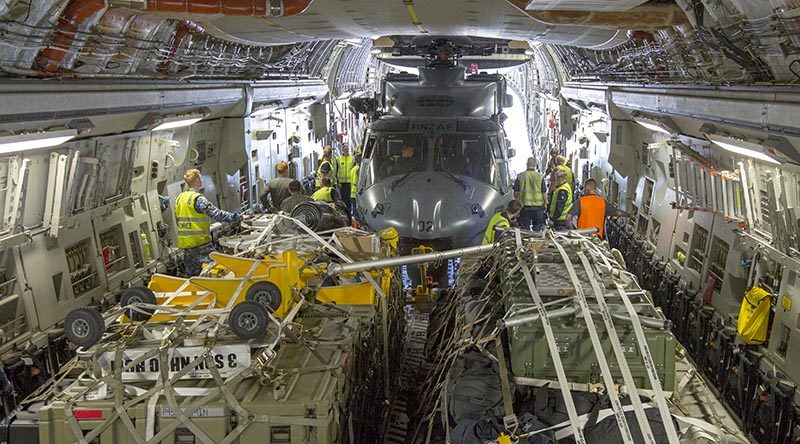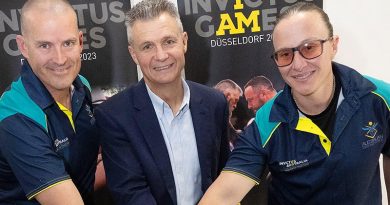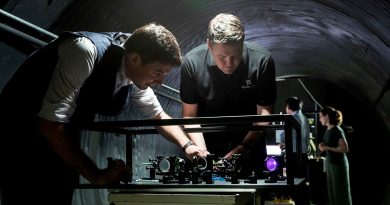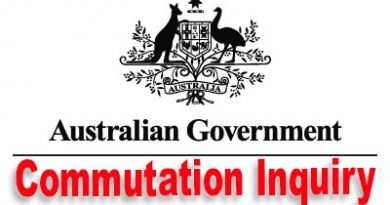Help and hardware from across the ditch

Deploying NH90 helicopters overseas is well-rehearsed by the Royal New Zealand Air Force, as bushfire relief operations in Australia have demonstrated.
CAPTION: A Royal New Zealand Air Force NH-90 helicopter loaded on a RAAF C-17A Globemaster III en-route from RNZAF Base Ohakea to RAAF Base Richmond for Operation Bushfire Assist tasking. Photo by Corporal Nicci Freeman. Story by Eamon Hamilton. Edited by CONTACT.
RELATED STORIES: Operation Bushfire Assist 19-20
On 5 January, New Zealand Defence Minister Ron Mark announced the deployment of three NH90s from RNZAF Base Ohakea’s No. 3 Squadron.
The following day, a Royal Australian Air Force C-17A Globemaster arrived to collect the first NH90 for the 2300km trip across the Tasman Sea.
Efficiency from the No. 3 Squadron maintenance team was critical to ensuring the NH90s could be quickly deployed, ‘reassembled’ at their destination, and flown on disaster relief missions.
Fortunately, No. 3 Squadron is well-practised in deploying abroad according to its Maintenance Flight Commander, Squadron Leader Rebecca Willis.
“We’ve previously deployed via an Australian C-17A, and onboard HMNZS Canterbury, on a number of occasions,” Squadron Leader Willis said.
“Last year, we took three NH90s to Exercise Talisman Sabre [in Queensland] and we deployed two aircraft in support of the Solomon Islands election in 2019.”
The NH90 can accommodate up to 18 passengers or lift several tonnes of equipment, making them extremely useful in carrying defence personnel, emergency services, or even civilian evacuees in areas ravaged by bushfires.
Each helicopter weighs 6.7 tonnes for transport (up to 11 tonnes in flying configuration) and the C-17A will carry one NH90 at a time to Australia.
To fit inside the C-17A’s cargo bay, the NH90’s main and tail rotor blades were removed, and the aircraft’s tail section folded.
Loadmasters, air movements personnel and RNZAF technicians carefully moved the helicopter onto the C-17A’s cargo ramp using a winch, and secured it to the floor of the cargo cabin when correctly positioned in accordance with C-17A weight-and-balance charts.
For the three-hour trip across the Tasman, the C-17A also carried RNZAF personnel, servicing equipment and the helicopter’s rotor blades which were individually packed into purpose-built trunks.
On the evening of 6 January, the C-17A touched down at RAAF Base Richmond with the first NH90 on board.
The timing of the delivery coincided with some modest rainfall at Richmond – a good omen from the Land of the Long White Cloud.
RAAF Base Richmond was chosen over Nowra as the location to reassemble the NH90s because of the availability parking space and spare hangars for No. 3 Squadron to work in.
“We’ve previously done this rebuild in more austere conditions – so doing it in a hangar, with accommodation for us to sleep in every night, is actually quite luxurious,” Squadron Leader Willis said.
“We’ve also recently purchased a ‘spider crane’, which will be a real enabler for the squadron.”
The ‘spider crane’ derives its name from stabilising arms that give it an arachnid appearance – albeit with only four legs.
It is used by technicians to hoist each of the NH90’s rotor blades back into position atop the aircraft.
Despite their largely ‘light-weight’ constructed from carbon fibre and titanium, each rotor blade weighs 112kg and measures nearly 8m long.
Aircraft Technician with No. 3 Squadron Sergeant Nick Hare said the mechanisms for mounting the rotor blades were quite simple.
“The helicopter was designed to be disassembled and reassembled quite quickly,” Sergeant Hare said.
“As soon as we get it off the C-17A, we can be putting blades on the helicopter within about half an hour of rolling it into the hangar.”
“We can have all of the blades back on the helicopter within about 45 minutes – but you then need to check and secure the bolts and other connections – and that takes some time.”
Once each NH90 was declared ready, they were in the field and tasked in support of bushfire recovery operations.
The departure of each the first two NH90s from RAAF Base Richmond closely coincided with a RAAF C-17A bringing the next helicopter and personnel from RNZAF Base Ohakea.
No. 3 Squadron Logistics Officer Flight Lieutenant Pete Homburg said the Australian Defence Force’s Joint Movements Control Office (JMCO) had provided essential logistics support for the RNZAF team across two bases.
“We’ve had about 15 tonne of freight brought across from Ohakea on the three C-17As,” Flight Lieutenant Homburg said.
“The freight has come into Richmond, which is being used as a staging post to rebuild the aircraft, and then require road-freighting down to Nowra.”
By the evening of 10 January, all three NH90s had been assembled and had joined Operation Bushfire Assist 19-20.
Squadron Leader Willis said the No. 3 Squadron team was proud to be in Australia helping its Anzac allies.
.
.
.
.
.
.
.

.
.





